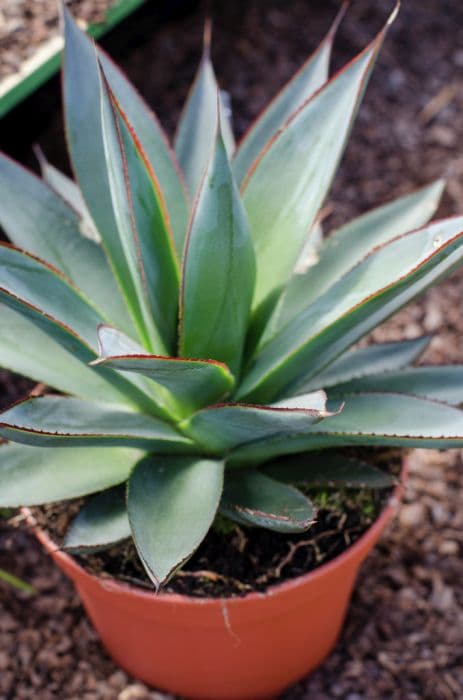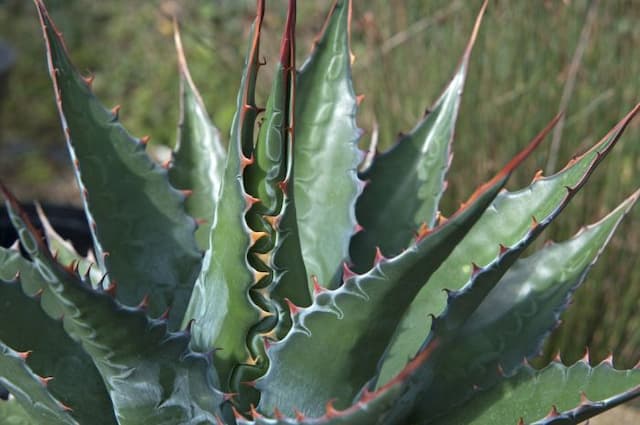Corn Plant 'Warneckei' Dracaena fragrans (Deremensis Group) 'Warneckei' (v)

ABOUT
The Dracaena fragrans 'Warneckei', commonly known as the Warneck Dracaena, is a striking houseplant notable for its distinctive foliage. This plant features long, strap-like leaves that are arranged in a rosette pattern, emerging from a central stalk. The leaves of the Warneck Dracaena are variegated, displaying a mix of colors. They typically have a deep green background with contrasting stripes of white or light green running parallel to the central vein. This variegation creates a bold and eye-catching effect, making the plant a popular choice for interior decoration. The leaves are glossy and may exhibit a slight arch, which adds to the plant's visual appeal. The overall impression of the Warneck Dracaena is one of elegance and vibrancy, which can enliven a space with its lush and tropical look.
About this plant
 Names
NamesFamily
Asparagaceae
Synonyms
Warneck Dracaena, Warneckii, Striped Dracaena, Warneckei Dragon Tree
Common names
Dracaena deremensis 'Warneckei', Dracaena fragrans 'Warneckei', Pleomele fragrans 'Warneckei'.
 Toxicity
ToxicityTo humans
The plant commonly known as Corn Plant is not highly toxic to humans. However, if ingested, it can cause mild symptoms, such as stomach discomfort, nausea, or vomiting. Contact with the sap may cause skin irritation in some people. It is generally advised to keep this plant out of reach of children who may chew on its foliage.
To pets
The Corn Plant is toxic to pets, particularly cats and dogs. If a pet ingests any part of this plant, it can lead to symptoms such as vomiting, loss of appetite, depression, drooling, and in some cases, dilated pupils in cats. It contains saponins, which are the toxic compounds responsible for these symptoms. If you suspect your pet has ingested part of this plant, it is important to consult a veterinarian promptly.
 Characteristics
CharacteristicsLife cycle
Perennials
Foliage type
Evergreen
Color of leaves
Variegated
Height
4-6 feet (1.2-1.8 meters)
Spread
2-3 feet (0.6-0.9 meters)
Plant type
Shrub
Hardiness zones
10
Native area
Africa
Benefits
 General Benefits
General Benefits- Low-Maintenance: Dracaena Warneckei requires minimal care, making it ideal for busy individuals or those new to plant care.
- Adaptability: This variety can adapt to a range of light conditions, from low light to partial shade, making it a flexible choice for various indoor environments.
- Drought-Tolerant: It can survive occasional watering lapses, which is perfect for people who travel or occasionally forget to water their plants.
- Aesthetic Appeal: With its striking variegated leaves in shades of green and white, Dracaena Warneckei adds a decorative touch to any space.
- Long-Living: Known for its longevity, this plant can be a long-term addition to your home or office setting.
- Improves Humidity: By releasing moisture into the air, it can help improve the humidity of a room which can be beneficial during dry seasons.
- Non-Toxic to Pets: Dracaena Warneckei is considered non-toxic to cats and dogs, making it a safe choice for pet owners.
 Medical Properties
Medical PropertiesThis plant is not used for medical purposes.
 Air-purifying Qualities
Air-purifying QualitiesThe Dracaena 'Warneckei' is known to remove various pollutants from the air including benzene, formaldehyde, trichloroethylene, and xylene.
 Other Uses
Other Uses- Education and Research: Dracaena Warneckei is often used in educational settings and botany research to study plant growth patterns, leaf variegation, and chlorophyll production.
- Cultural Significance: In certain cultures, the plant is associated with prosperity and is used in rituals or given as a gift during significant events.
- Art and Craft: The leaves of Dracaena Warneckei can be used in art projects or as a natural decorative element in craft activities, such as leaf printing or collage.
- Photography: As a visually striking plant, it's frequently used in interior design and plant arrangement photography portfolios.
- Sound Absorption: The dense foliage of the Dracaena Warneckei can help absorb sound, making it a practical addition to noisy offices or homes.
- Privacy Screen: When grown in clusters, this tall plant can act as a living privacy screen on patios, balconies or in garden spaces.
- Theme Gardens: A popular choice for creating tropical, jungle, or African-themed gardens due to its exotic appearance.
- Mindfulness Practice: The act of caring for this plant, observing its growth, and enjoying its beauty can be incorporated into mindfulness and meditation practices.
- Color Therapy: The green and white stripes on the leaves are thought to contribute to a calming environment and can be used in color therapy as a way to relieve stress.
- Literature and Film: The Dracaena Warneckei occasionally appears as a prop or setting detail in books and movies to evoke an exotic or luxurious ambiance.
Interesting Facts
 Feng Shui
Feng ShuiThe plant commonly known as "Warneckii" is considered to bring positive energy into a space, purifying the air and smoothing the flow of chi. It’s recommended to place the Warneckii in the wealth area of your home or office (southeast) to bring prosperity, or in the health area (east) to promote well-being.
 Zodiac Sign Compitability
Zodiac Sign CompitabilityThe Warneckii is not used in astrology practice.
 Plant Symbolism
Plant Symbolism- Longevity: Dracaena fragrans, commonly known as Corn Plant, is known for its long lifespan, which symbolizes the endurance and persistence of life.
- Prosperity: In Feng Shui, the Corn Plant is believed to bring prosperity to a home or business, reflecting its lush, evergreen foliage.
- Purity: The Corn Plant is thought to purify the air, symbolically representing cleanliness, purity, and the removal of negative energy from an environment.
- Positive Energy: With its strong vertical growth, the Corn Plant is associated with upward energy and vitality, symbolizing an increase in positive vibes.
- Balance: The variegated leaves of the 'Warneckei' variety symbolize balance and harmony due to the contrasting colors that integrate to form a whole.
 Water
WaterThe Corn Plant should be watered when the top inch of soil feels dry to the touch, typically every 1-2 weeks, depending on environmental conditions. Water thoroughly until water drains from the bottom of the pot, but do not allow the plant to sit in standing water as this can cause root rot. It is better to err on the side of underwatering than overwatering. In a fixed amount of time like a month, you might water this plant approximately 2-4 times, using about 16-32 ounces of water each time, adjusted for factors like light, temperature, and pot size.
 Light
LightThe Corn Plant thrives in moderate, indirect light conditions. It should be placed in a location where it can receive bright, filtered light, avoiding direct sunlight which can scorch its leaves. An east or north-facing window would be an ideal spot, providing a balance of light without the harsh midday sun.
 Temperature
TemperatureThe Corn Plant prefers temperatures between 60 to 75 degrees Fahrenheit. It can survive minimum temperatures of 50 degrees Fahrenheit and maximum temperatures up to 90 degrees Fahrenheit, but extremes should be avoided. The ideal temperature range ensures healthy growth and prevents stress on the plant.
 Pruning
PruningPruning the Corn Plant is important to maintain its shape and remove any yellow or brown leaves. Cut just above a node or growth point using clean, sharp shears. Pruning can be done at any time of the year but is best performed in the spring or early summer to allow for vigorous regrowth. It is not necessary to prune often, once a year or when you notice dead or damaged leaves is generally sufficient.
 Cleaning
CleaningAs needed
 Soil
SoilThe best soil mix for Corn Plant is a loose, well-draining potting mix with a pH of 6.0 to 6.5. A mix of one part peat, one part perlite, and one part loamy soil works well.
 Repotting
RepottingCorn Plants should be repotted every 2-3 years, or when they become root-bound.
 Humidity & Misting
Humidity & MistingCorn Plants prefer humidity levels of 40-50% but can tolerate a range from 30-60%.
 Suitable locations
Suitable locationsIndoor
Place in bright, indirect light and away from drafts.
Outdoor
Shelter from direct sun and protect from frost.
Hardiness zone
10-12 USDA
 Life cycle
Life cycleDracaena fragrans 'Warneckei', commonly known as Warneck Dracaena, begins its life cycle when a seed germinates, typically in warm, moist soil conditions where it develops a root system and a shoot that emerges above the soil. As a tropical plant, once the shoot surfaces, it grows into a young plant with characteristic green leaves with white or yellow variegation running along their edges. Over time, the young Warneck Dracaena will become an established plant, developing a woody stem and forming a rosette of leaves at the tip of each stem. The mature Warneck Dracaena then enters the vegetative stage lasting many years, where it focuses on growing taller and broader in ideal indoor conditions, with the capability to reach several feet in height. During its mature phase, if conditions are optimal, the plant can produce clusters of fragrant white flowers, although flowering is rare in indoor conditions. Finally, as the plant ages, its growth slows, older leaves yellow and drop, and it may become susceptible to pests or diseases, eventually reaching the end of its life cycle.
 Propogation
PropogationPropogation time
Spring to Summer
The most popular method for propagating Dracaena fragrans 'Warneckei', commonly known as Warneck Dracaena, is through stem cuttings. This process is typically done in the spring or summer when the plant is actively growing. To propagate, select a healthy stem and cut a 4 to 6-inch (10 to 15 cm) section, ensuring that it has at least two or three leaf nodes. Allow the cutting to dry for a few hours to form a callus on the cut end, which helps to prevent rot. Then, plant the cutting in a pot filled with a well-draining potting mix. Water the soil lightly to keep it moist, but not soggy, and place the pot in a warm area with bright, indirect light. Roots should develop within a few weeks, after which the plant can continue to grow under normal care conditions.









